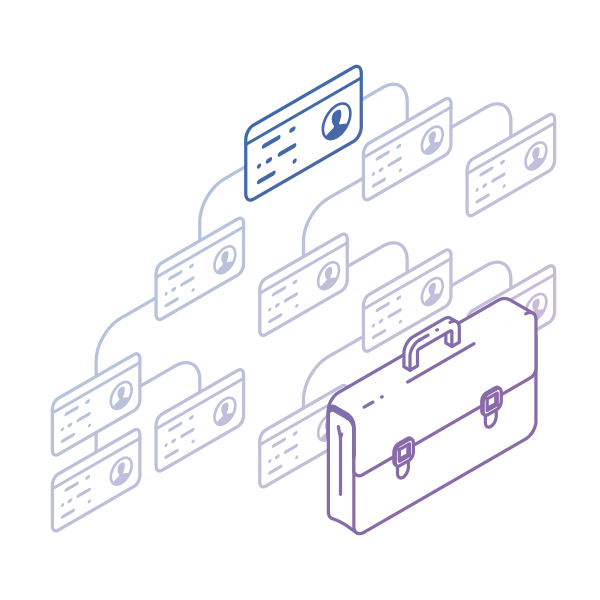Did you know that 42% of project management practitioners worldwide believe their organization doesn't fully grasp the value of project management? Interestingly, 87% of senior executives think their organization fully comprehends the same value.* A significant difference in opinions under the same roof.
We believe this confusion is due to a disconnect from the core principles of project management. To address this gap, we delve into the fundamentals of project management—exploring its significance and examining its features, benefits, and more.
What Is Project Management?
Project management is the process of planning, organizing, executing, and monitoring work activities to achieve a specific goal within a defined timeframe and budget. It involves applying knowledge, skills, tools, and techniques to manage big pieces of work (known as projects) efficiently and effectively.
Every project is a temporary endeavor helping to produce a unique product, service, or result. It is temporary because it has a definite beginning and end, and is unique because it is not a routine operation.
Projects are different from operations, which are ongoing and repetitive. For example, running a manufacturing plant is an operation, while installing a new system is a project. Projects are also different from programs, which are a collection of related projects.
Projects can vary greatly in size and complexity, from small and simple to large and complex. They can also vary in duration, from a few weeks to several years.
Key Features of Projects
Regardless of their size or complexity, all projects have:
- specific goals and objectives,
- are subject to constraints such as time, cost, and scope,
- require resources.
Key Project Management Areas
Project management includes the following key areas:
- Scope Management: Involves defining the project's objectives, deliverables, and requirements, ensuring they are met within the project's scope.
- Time Management: Refers to creating a project schedule, setting deadlines, and ensuring the project is completed on time.
- Cost Management: This involves creating a budget for the project, monitoring expenses, and ensuring that the project is completed within the allocated budget.
- Quality Management: Ensuring that projects meet quality standards and that the deliverables meet the needs of the stakeholders.
- Communication Management: This involves ensuring all stakeholders are informed about the project's progress, issues, and changes.
- Risk Management: This involves identifying potential risks and developing strategies to mitigate them.
By focusing on these key areas, you will ensure projects are completed successfully and meet the needs and expectations of the stakeholders.
What Are the 5 Key Project Management Phases?
The project management cycle or life cycle includes several phases that a project goes through, from initiation to completion. It provides a structured way to create, execute, and finish a project. The project management process consists of the following phases:
1. Initiation Phase
The initiation phase is the project management cycle’s first stage, during which you identify the project's purpose, objectives, and stakeholders. You also define the project scope, constraints, and assumptions. At this stage, organizations initiate a project with a project charter that outlines the project's vision, mission, goals, and objectives.
2. Planning Phase
During the project’s life cycle planning phase, you create a detailed project plan that outlines the project's scope, timeline, budget, resources, and risks.
Project planning can vary depending on the project management guidelines organizations adopt. In a more traditional approach, organizations develop the project plan with greater detail upfront, specifying all milestones and their deadlines within a project charter.
Agile methodologies present an alternative approach, advocating for iterative planning. The initial project plan is created with only essential details, and additional planning occurs as needed in a "just-in-time" manner throughout the project execution. Agile planning involves frequent value delivery, constantly receiving end-user feedback, cross-functional collaboration, and commitment to continuous improvement.
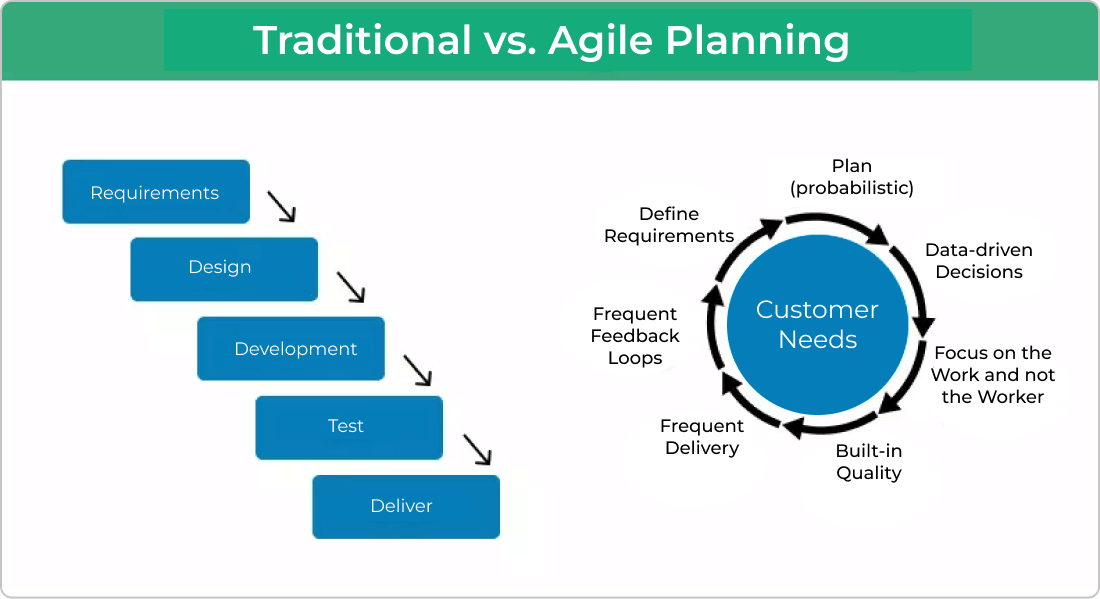 Traditional and Agile project planning
Traditional and Agile project planning
3. Execution Phase
In the execution phase, you implement your project plan and carry out the project activities. You also monitor the project's progress and make any necessary changes to ensure that the project stays on track. You should also manage the project team, communicate with stakeholders, and resolve any issues or conflicts at this stage.
4. Monitoring and Control Phase
The monitoring and control phase is the fourth stage of the project management cycle, during which you monitor the project's progress and performance and make any necessary adjustments to ensure that the project stays on track. You also manage the project risks and issues to ensure the team works efficiently and effectively.
5. Closure Phase
The closure phase is the final phase of the project’s life cycle, during which you close the project and ensure all project deliverables have been completed and approved. You also conduct a project post-mortem to evaluate the project's success and identify any improvement lessons that can be applied to future projects.
Project Management Types
There are different types of project management methodologies that you can choose depending on the nature and scope of your project. Four popular project management approaches include Lean, Agile, and Waterfall.
Waterfall Project Management
Waterfall project management is a methodology that follows a linear, sequential approach to project management. It is based on the idea that each project phase must be completed before moving on to the next one.
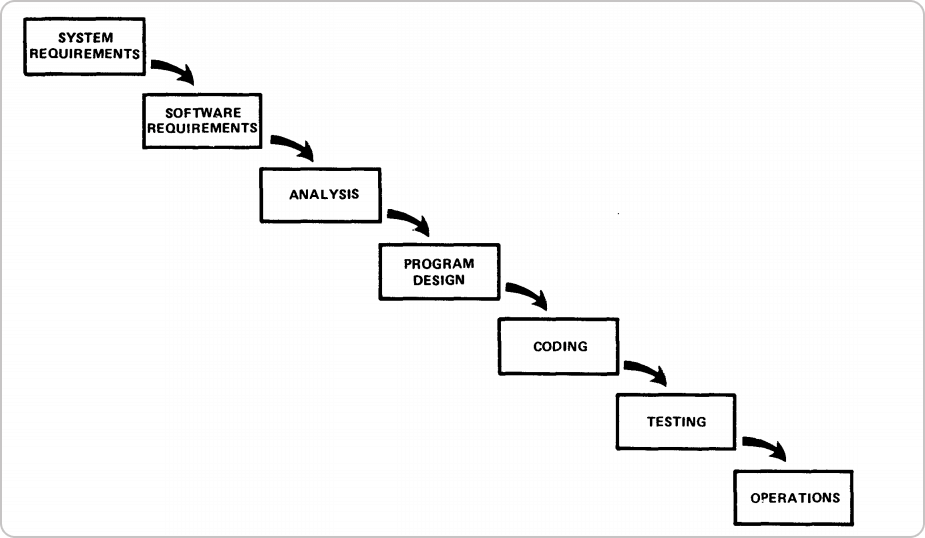
Image credit: "Managing the Development of Large Software Systems", Dr. Royce
In Waterfall project management, organizations define requirements upfront and follow a strict plan to execute every project. It is a stage-gate work management model where reviews are conducted before each stage to ensure that deliverables are completed successfully before moving on to the next phase. Some widely used frameworks in Waterfall projects include PRINCE2, Critical Chain Method, or the V-Model.
Lean Project Management
Lean project management is a methodology that focuses on maximizing value and minimizing waste. It is based on the Lean management principles, which aim to eliminate non-value-added activities in the production process.
In Lean project management, you break down your project into small, manageable work items and prioritize them based on their value to the customer. You also continuously monitor and improve your processes to eliminate waste and improve efficiency.
One of the most famous Lean/Agile approaches applied to project management is the Kanban method. Kanban is a visual and flexible approach to workflow optimization focused on transparency and continuous improvement to optimize overall efficiency.
Agile Project Management
Agile project management is an approach that focuses on flexibility, collaboration, and customer satisfaction. It’s rooted in the Agile Manifesto, which was developed in the context of software development, but it’s now widely used across industries and teams. The original premise of the Manifesto has four fundamental values: individuals and interactions, working software, customer collaboration, and responding to change.
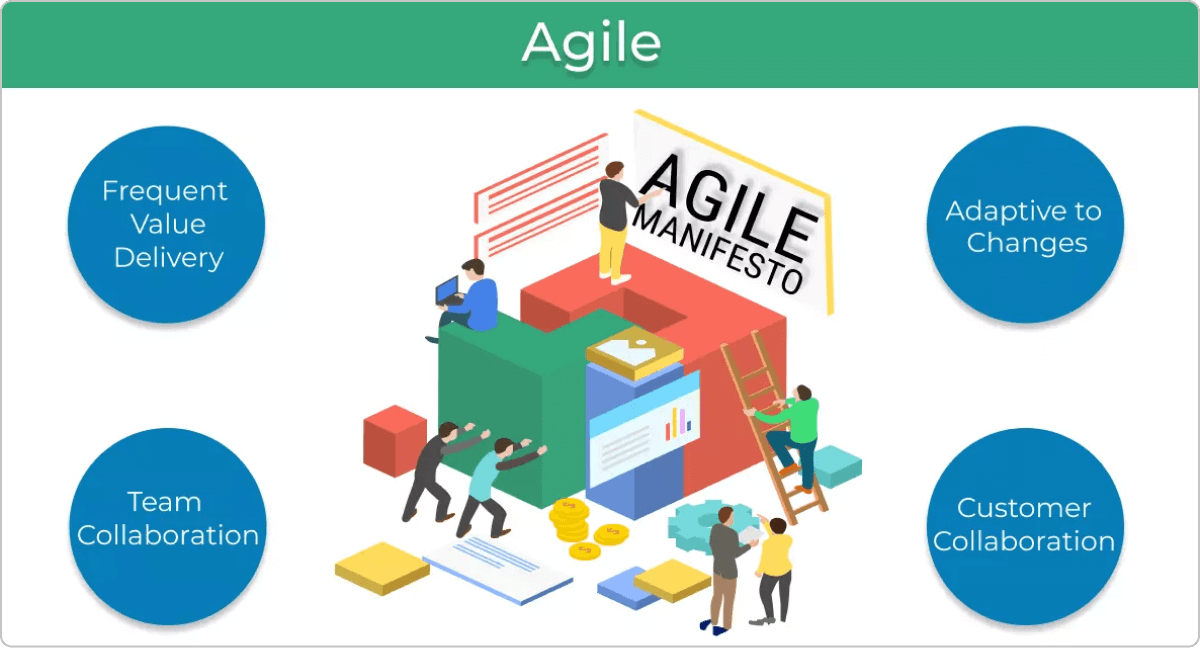 Agile core values
Agile core values
In Agile project management, you work iteratively and continuously deliver value that meets the customer's needs. Another key attribute is regularly reviewing and adapting your processes to improve performance.
Scrum is one of the most widely used Agile methodologies for software development, emphasizing iterative development and collaboration within a cross-functional team. It employs time-boxed iterations, called sprints, during which a specific set of tasks or features are developed, promoting adaptability, transparency, and continuous improvement in the software development process.
Why Is Project Management Important?
As discussed, project management is a critical factor that enables organizations to achieve their goals efficiently and effectively. By applying a structured approach to project management, organizations guarantee projects’ completion on time, within budget, and to the required quality standards.
Furthermore, project delivery efficiency is even more critical in high levels of economic uncertainty, such as the post-pandemic world we live in. Efficiency in project delivery shifts the spotlight to skillfully balancing the three crucial elements of every project – time, budget, and scope, commonly known as the project management triangle.
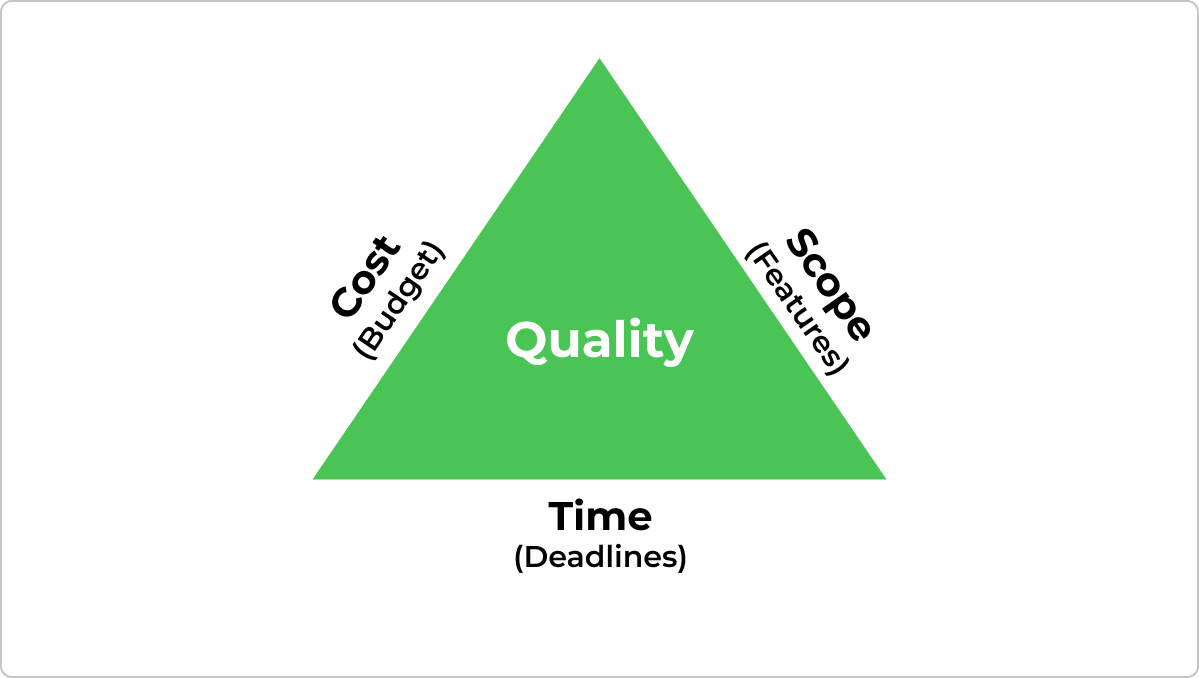 Project management iron triangle
Project management iron triangle
This section will further explore the key benefits of using project management.
6 Key Benefits of the Project Management Practice
-
Streamlines Work: At its core, project management practices enable work organization and standardization, ensuring that everyone involved has a clear understanding of a project’s pillars, such as objectives, scope, and stakeholders. This helps prevent misunderstandings and ensures everyone is aligned toward a common goal.
-
Delivers Consistent Results: Through systematic monitoring, adjustments, and applying best practices, project management minimizes variability and enhances the likelihood of delivering reliable and repeatable outcomes.
-
Enables Effective Planning: Following specific project management guidelines can help you plan more effectively, which helps to identify potential problems before they occur. This allows for early intervention, minimizing the impact on the project timeline and budget. Whether you follow traditional or agile project planning, sound planning is vital for making your project a success.
-
Promotes Better Communication: Communication is a critical factor in project success. Project management provides a framework for effective communication, ensuring that everyone is aware of a project’s progress and any changes to its scope.
-
Efficient Resource Management: Employing project management methodologies enhances visibility, guaranteeing efficient resource utilization. This includes managing budgets, timelines, and personnel to ensure the project is completed on time and within budget.
-
Helps to Reduce Costs: Project management minimizes unnecessary expenses and prevents costly issues by optimizing resource management, streamlining processes, and identifying risks early on.
5 Tips to Build Successful Project Management Teams
At Businessmap (formerly Kanbanize), we believe that focusing on a few key areas is essential to ensuring the success of your project management team.
1. Enable Communication and Collaboration
Effective communication is essential for successful project management teams. Ensure that your team members communicate regularly and have the tools they need to do so.
According to PMI research on the future of project work, sharing knowledge, working as a team, and participating in finding solutions are essential motivators for young project managers aspiring to make a career in the field.
2. Define Clear Processes and Work Delivery Policies
Having clear and defined processes is crucial for a successful project management team. Have operational policies for every project stage, from planning to execution to monitoring and control. Ensure that everyone on the team understands the processes and what is expected of them.
ULMA Handling Systems significantly improved in just one year by using simple methods to understand their processes better. They had important goals, like keeping track of projects, working well together, making decisions faster, and finishing projects on time.
The teams learned and used the kanban approach and some fundamental kanban practices for their complex engineering projects, which usually take 1.5 to 2.5 years. This helped them see the entire workflow and set clear policies for handling project challenges.
Source: ULMA Handling Systems Case Study
3. Understand Leadership
A strong project leader can motivate and inspire the team, keep everyone on track, and focused on project goals. Good leaders should also be able to identify and tackle any issues that arise during the project.
There are various leadership models, including transformative, servant, authentic, and others, depending on their focus and priorities. Whether you adhere to the traditional person-centered way of leading (vertical leadership) or the team-centered shared leadership way (horizontal), finding a good balance is important. This helps make projects run better and more efficiently. Measured together, person-centered and team-centered leadership explain close to 30% of projects' success.
4. Support Continuous Learning Mindset and Ownership
A proficient team is vital for the success of project management endeavors. Foster a culture of curiosity and continuous learning within your team, allowing them the autonomy to take ownership of their work. This keeps team members motivated for improvement and enhances their decision-making capabilities.
5. Use Proper Tools and Resources
Tools and resources are essential for a successful project management team. You need to ensure your team has access to the tools and resources they need to complete the project successfully. This may include project management software, training, coaching, and other resources.
Focus on these crucial areas to guarantee your project management team is well-equipped to tackle any upcoming project flawlessly.
The Future of Project Management
Here are the top trends shaping the future of project management: the widespread use of AI in various business aspects, the impact of digital transformation, the drive from younger project professionals, and more.
AI Trends
Many project managers are starting to use artificial intelligence (AI) in their projects, and more than half of the people surveyed by the Project Management Institute (PMI) believe that AI will have a “transformative” impact in the field. One big way AI can be helpful for project managers is through automation. This can include making reports, automating tasks, or gathering information from different sources. Some of the more advanced uses of AI technologies include using virtual project assistants or using ML to detect patterns and improve project prioritization. (Source: PMI)
Digitization and Digital Transformation
Innovation and digital transformation projects are the most prioritized projects nowadays. As such, digitizing employee interaction and collaboration has been a top priority for 85% of organizations since the Covid-19 break-out.
Addressing Grand Challenges
Understanding the role of projects in addressing global challenges such as climate change, poverty, or social inequality will be a prominent theme in the profession's future. Issues of this magnitude should be tackled by more than large-scale projects, which are the priority of governments and policymakers. Instead, this calls for project mobilization across different scales, from everyday projects to grand programs and initiatives. (Source: PMI)
Professional Motivation
The future of the profession underscores the personal motivations of project professionals. Projects are evolving to offer a chance for genuine contribution, from generating new ideas to bringing them to life. Prioritizing innovation and change initiatives becomes crucial in delivering substantial business value. Notably, the social impact of projects is gaining prominence, influencing the motivations of project managers. (Source: PMI)
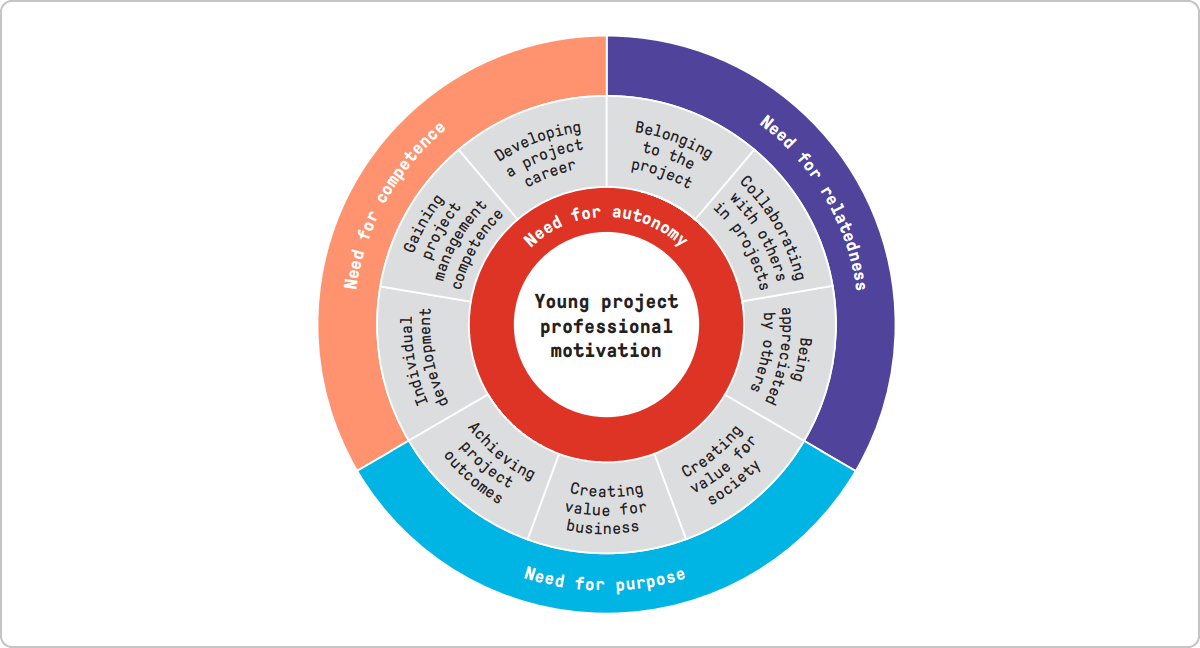 Conceptual model of young professional motivation (Lechter & Huemann, 2023)
Conceptual model of young professional motivation (Lechter & Huemann, 2023)
Image credit: PMI
*Statista: Understanding the value of project management worldwide 2018
Businessmap is the most flexible software
to align work with company goals









